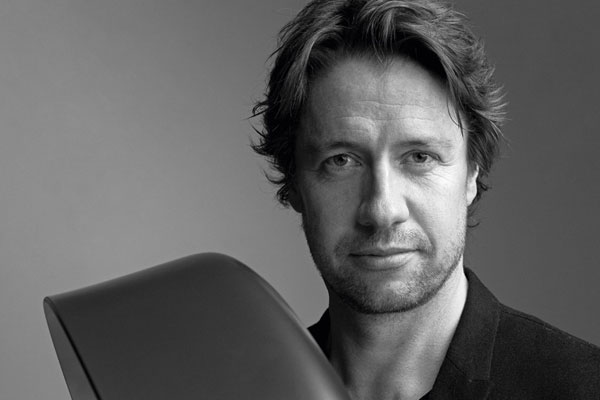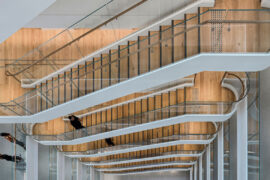In light of the release of his new LP Grand lighting system for Louis Poulsen, Danish designer Christian Flindt tells us how he started working with Louis Poulsen and the silent quality of light. Asih Jenie writes.

November 2nd, 2016
Born in 1972, Christian Flindt graduated with an MAA and MDD from Aarhus School of Architecture in 2002. His passion, however, was designing furniture, which he has likened to miniature architecture. Flindt opened his own design practice in 2003. During his first few post-university years, his portfolio was made up by sculptural pieces of furniture. During a furniture exhibition in Denmark, Flindt’s work caught the eye of Louis Poulsen. The brand was intrigued by Flindt’s material exploration and invited the young designer to design a lighting piece for them.
A decade has gone by and Flindt has developed the Flindt 220 floor and pendant lamps, the Flindt 475 pendant lamp and the Flindt Bollard lamp. Flindt’s latest and largest lighting product for Louis Poulsen is the LP Grand series, launched just last week in Singapore as part of Louis Poulsen’s Fall/Winter 2016 collection. Designed to illuminate large spaces with high ceilings, LP Grand is available in three diameters – 580, 880 and 1,480 millimetres – and can be suspended from or surface mounted on the ceiling (the smallest one can also be mounted on the wall).
LP Grand’s simple and versatile form belies a complex mechanism. It features a set of circular reflectors placed around a central horizontal diffuser. These reflectors create four rings of light that surround its central diffuser by cleverly bounce and diffuse the light, resulting in a gentle and graceful glow on the outside. Asih Jenie spoke to Christian Flindt to find out more.
How did you start working with Louis Poulsen?
Louis Poulsen approached me after seeing my furniture at one of the exhibition in Denmark. I didn’t have a lighting product on display. I guess what they saw in my furniture was the will to explore with different materials and try to push some boundaries with experiments.
How did you make the jump from furniture design to lighting design?
I like to create dialogues with my creations. It took me a while to kind of grasp how I could have a dialogue with light. It’s easy with people – people talk. For example when I designed a chair, I could have the users telling me ‘you need the backrest a little bit higher’ and so on. But light is silent so you need to find out in a different ways. I am little bit more experienced now [laughs].
What was the biggest challenge in creating LP Grand?
Definitely incorporating new technologies to realise this very big object. Louis Poulsen is famous for glass and metal pieces but LP Grand is made with high-performance plastics (ABS, PE and PUR) commonly used in the automotive industry. Louis Poulsen has invested quite a lot to realise this project. It’s a great material because you can create volume with it but it has a softer look, which is little bit different from what’s available at the market now. Plus, we are able to make it affordable for designers and architects to use in their projects.
Tell me about your studio in Denmark.
I have a studio space that I share with three other designers. All of us are independent designers and we each work on our own projects, sometimes with brands, sometimes under our own brand. In Denmark, most of independent designers work and share spaces like this, it makes sense for us. Also, it’s easier to bounce ideas off each other.
How do you think lighting will move forward?
I think with LED, lighting will become more integrated to architectural surfaces. You see more companies being very clever in integrating it and delivering products that not only you can mount on the wall or the ceiling, they’ve made them so you can plaster them with wall finishes in a very smart way. But of course there are still so many new possibilities to do a light fixture so certainly I hope the end user would still like to have a cosy space with a lamp here and there.
Louis Poulsen
louispoulsen.com
ChristianFlindt
christianflindt.dk
INDESIGN is on instagram
Follow @indesignlive
A searchable and comprehensive guide for specifying leading products and their suppliers
Keep up to date with the latest and greatest from our industry BFF's!

Gaggenau’s understated appliance fuses a carefully calibrated aesthetic of deliberate subtraction with an intuitive dynamism of culinary fluidity, unveiling a delightfully unrestricted spectrum of high-performing creativity.

It’s widely accepted that nature – the original, most accomplished design blueprint – cannot be improved upon. But the exclusive Crypton Leather range proves that it can undoubtedly be enhanced, augmented and extended, signalling a new era of limitless organic materiality.

How can design empower the individual in a workplace transforming from a place to an activity? Here, Design Director Joel Sampson reveals how prioritising human needs – including agency, privacy, pause and connection – and leveraging responsive spatial solutions like the Herman Miller Bay Work Pod is key to crafting engaging and radically inclusive hybrid environments.

Christopher Boots marries traditional and cutting-edge materials and techniques to create beautiful objects.

On the eve of Cerith Wyn Evans’ first museum exhibition in the Asia-Pacific region, we interviewed the internationally acclaimed contemporary artist in a wide-ranging discussion spanning Japanese gardens, the aesthetics of Buddhism and the Australian light.
The internet never sleeps! Here's the stuff you might have missed

Brad Krauskopf, CEO & Founder of Hub Australia, tells us about Hassell’s design for Hub Australia Martin Place.

To mark a full year of Bradhly Le’s young studio, the team at RIZEN Atelier share their impressions and inspirations so far.